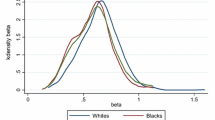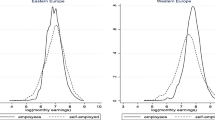Abstract
The relationship between the usage of employment tests—particularly ability tests-and job performance criteria has been extensively studied. The usage of testing was reported to have declined after the landmark personnel selection caseGriggs (1971). Models of selection utility were reviewed, and an ecological systems theory of test incidence and the American economy was developed. For both ability tests and non-personality employment tests, a positive relationship was hypothesized between the historical incidence of firms using tests and American Gross Domestic Product. Using historical survey and economic data, results were consistent with the hypothesis involving ability testing incidence.
Similar content being viewed by others
References
Bishop, J. H. (1989). Is the test score decline responsible for the productivity growth decline?American Economic Review, 79, 178–197.
Brogden, H. E. (1949). When testing pays off.Personnel Psychology, 2, 171–183.
Campbell, J. P., & Campbell, R. J. (1988). Industrial-organizational psychology and productivity: The goodness of fit. In J. P. Campbell & R. J. Campbell (Eds.),Productivity in organizations: New perspectives from industrial and organizational psychology (pp. 82–93). San Francisco: Jossey-Bass.
Cascio, W. F. (1991).Costing human resources: The financial impact of behavior in organizations (3rd ed.). Boston: PWS-Kent.
Cronbach, L. J., & Gleser, G. C. (1965).Psychological tests and personnel decisions (2nd ed.). Urbana, IL: University of Illinois Press.
Denison, E. F. (1985).Trends in American economic growth, 1929–1982. Washington, DC: Brookings Institution.
Friedman, T., & Williams, E. B. (1982) Current uses of tests for employment. In A. K. Wigdor & W. R. Garner (Eds.),Ability testing: Uses, consequences, and controversies. Part II: Documentation section (pp. 99–169). Washington, DC: National Academy Press.
Galbraith, J. K. (1989).Balancing acts: Technology, finance, and the American future. New York: Basic Books.
Gallup Report. (1984, May). No. 224, pp. 28–30.
Gordon, R. A., Lewis, M. A., & Quigley, A. M. (1988). Can we count on muddling through theg crisis in employment?Journal of Vocational Behavior, 33, 424–451.
Griggs v. Duke Power, 401 U.S. 424 (1971).
Hartigan, J. A., & Wigdor, A. K. (Eds.). (1989).Fairness in employment testing: Validity generalization, minority issues, and the General Aptitude Test Battery. Washington, DC: National Academy Press.
Harville, D. L. (1994). The historical incidence of testing in employment selections. Unpublished manuscript.
Hawk, J. (1986). Real world implications ofg.Journal of Vocational Behavior, 29, 411–412.
Heilbroner, R. L., & Thurow, L. C. (1987).Economics explained (rev. ed.). New York: Touchstone.
Hunter, J. E., & Hunter, R. F. (1984). Validity and utility of alternative predictors of job performance.Psychological Bulletin, 96, 72–98.
Hunter, J. E., & Schmidt, F. L. (1982a). Ability tests: Economic benefits versus the issue of fairness.Industrial Relations, 21, 293–308.
Hunter, J. E., & Schmidt, F. L. (1982b). Fitting people to jobs: The impact of personnel selection on national productivity. In M. D. Dunnette & E. A. Fleishman (Eds.),Human performance and productivity: Vol. 1. Human capability assessment (pp. 233–284). Hillsdale, NJ: Lawrence Erlbaum.
Judiesch, M. K., Schmidt, F. L., & Mount, M. K. (1992). Estimates of the dollar value of employee output in utility analyses: An empirical test of two theories.Journal of Applied Psychology, 77, 234–250.
Kucera, C. L. (1973).The challenge of ecology. Saint Louis: C. V. Mosby.
Levin, H. M. (1989). Ability testing for job selection: Are the economic claims justified? In B. R. Gifford (Ed.),Test policy and the politics of opportunity allocation: The workplace and the law (pp. 211–232). Boston: Klewer.
McHenry, J. J., Hough, L. M., Toquam, J. L., Hanson, M. A., & Ashworth, S. (1990). Project A validity results: The relationships between predictor and criterion domains.Personnel Psychology, 43, 335–354.
Office of the President. (1991).Economic report of the President. Washington, DC: Government Printing Office.
Office of the President. (1993).Economic report of the President. Washington, DC: Government Printing Office.
Ree, M. J., & Earles, J. A. (1994). The ubiquitous predictiveness ofg. In C. Walker, M. Rumsey, & J. Harris (Eds.),Personnel selection and classification (pp. 127–135). Hillsdale, NJ: Lawrence Erlbaum.
Schmidt, F. L., Hunter, J. E., McKenzie, R. C., & Muldrow, T. W. (1979). The impact of valid selection procedures on workforce productivity.Journal of Applied Psychology, 64, 609–626.
Stein, H., & Foss, M. (1992)An illustrated guide to the American economy: A hundred key issues. Washington, DC: AEI Press.
U.S. Department of Labor. (1983).The economic benefits of personnel selection using ability tests: A state of the art review including a detailed analysis of the dollar benefit of U.S. Employment Service placements and a critique of the low-cutoff method of test use (U.S. Employment Service Test Research Report No. 47). Washington, DC: Author.
When quotas replace merit, everybody suffers. (1993, February 15).Forbes, pp. 80–102.
Author information
Authors and Affiliations
Additional information
The views expressed are those of the author and not necessarily those of the U.S. Air Force, the Department of Defense, or the U.S. government.
Rights and permissions
About this article
Cite this article
Harville, D.L. Employment test usage as a predictor of gross domestic product. J Bus Psychol 11, 399–408 (1997). https://doi.org/10.1007/BF02195902
Issue Date:
DOI: https://doi.org/10.1007/BF02195902




